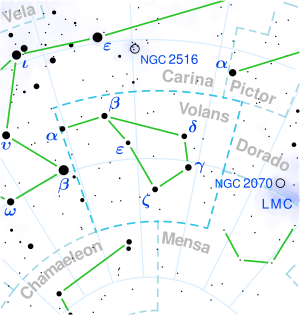| Observation data Epoch J2000.0[1] Equinox J2000.0[1] | |
|---|---|
| Constellation | Volans |
| Right ascension | 08h 55m 16.81719s |
| Declination | −67° 15′ 55.7009″ |
| Apparent magnitude (V) | 7.82[2] |
| Characteristics | |
| Evolutionary stage | Red-giant branch star[3] |
| Spectral type | K1 III[3] |
| B−V color index | 1.11[2] |
| J−H color index | 0.537[4] |
| J−K color index | 0.693[4] |
| Astrometry | |
| Radial velocity (Rv) | 20.09 ± 0.14[5] km/s |
| Proper motion (μ) | RA: 25.253[6] mas/yr Dec.: 25.659[6] mas/yr |
| Parallax (π) | 5.4618 ± 0.0187 mas[6] |
| Distance | 597 ± 2 ly (183.1 ± 0.6 pc) |
| Details[3] | |
| Mass | 1.22±0.11 M☉ |
| Radius | 8.68±0.34 R☉ |
| Luminosity | 29.5+1.3 −1.0[7] L☉ |
| Surface gravity (log g) | 2.648±0.037 cgs |
| Temperature | 4664±53 K |
| Metallicity [Fe/H] | −0.19±0.06 dex |
| Rotational velocity (v sin i) | 2.5±0.3[7] km/s |
| Age | 5.2±1.4 Gyr |
| Other designations | |
| Database references | |
| SIMBAD | data |
HD 76920 is a solitary[8] orange-hued star with an orbiting exoplanetary companion in the southern constellation of Volans, close to the border with Carina. With an apparent magnitude of 7.82, it is too faint to be seen by the naked eye from Earth but is readily observable through binoculars.[9] It is located at a distance of 597 light-years (183 parsecs) according to Gaia EDR3 parallax measurements, and is moving away at a heliocentric radial velocity of 20.09 km/s.
- ^ a b Cite error: The named reference
simbadwas invoked but never defined (see the help page). - ^ a b Cite error: The named reference
TYC2000was invoked but never defined (see the help page). - ^ a b c Cite error: The named reference
Jiang2023was invoked but never defined (see the help page). - ^ a b Cite error: The named reference
2MASSwas invoked but never defined (see the help page). - ^ Cite error: The named reference
DR2was invoked but never defined (see the help page). - ^ a b c Cite error: The named reference
EDR3was invoked but never defined (see the help page). - ^ a b Cite error: The named reference
Bergmann2021was invoked but never defined (see the help page). - ^ Cite error: The named reference
Wittenmyer2017was invoked but never defined (see the help page). - ^ Cite error: The named reference
binowas invoked but never defined (see the help page).

